What is zone offense in basketball
Zone offense is a specific type of basketball offense that utilizes actions such as screening, cutting, ball reversal, and dribble penetration against zone defenses to ultimately create scoring opportunities near the basket or near the perimeter areas of the court.
What is the importance of zone offense
It is important to have some type of zone offense available because if an offensive team is not properly prepared to face a zone defense with one or more strategies or tactics, then it would be very challenging for that offensive team to score against the zone defense efficiently, if at all.
What is an even front zone offense
An even front zone offense features a two-guard front in the form of a 2-1-2 or 2-3 alignment and it could be used as a strategy to beat odd front zone defenses such as the 1-1-3 zone defense, the 1-2-2 zone defense, the 1-3-1 zone defense, and the 3-2 zone defense.
The 2-1-2 alignment includes two players at the top near the slots, one high post player, and two players at the bottom near the corners. The 2-3 alignment features two players at the top near the slots, one high post player, and two players on the left and right side wings.
Additionally, with the 2-1-2 alignment or 2-3 alignment, if the main ball handler receives defensive pressure from the zone defender at the top, then that same ball handler could quickly reverse the ball to the teammate in the adjacent slot.
Also, the high post player within the even front alignments could be an effective weapon against odd front zones by executing certain actions such as screening the zone, diving to the basket, or using high low action.
Furthermore, the 2-1-2 alignment could potentially limit the effectiveness of the 1-3-1 zone by using the two offensive players in the corners to create scoring opportunities from the perimeter or near the basket.
What is an odd front zone offense
An odd front zone offense features a one guard front in the form of a 1-2-2, 1-3-1, or 1-4 alignment and it could be implemented as a counter strategy against even front zone defenses such as the 2-3 zone and the 2-1-2 zone.
The 1-2-2 alignment includes one player at the top above the three-point arc, two wing players, and two players near the low post blocks or short corners. The 1-3-1 alignment features one player at the top, a high post player, two wing players, and one player near the low post block or short corner.
The 1-4 alignment consists of a player at the top, two high post players, and two wing players. Furthermore, each of these alignments could be used to create scoring opportunities by attacking the high posts, wings, or corners of the even front zone defenses.
What are principles of zone offense
Zone offense general principles, strategies, and/or tactics to attack a zone defense include actions such as spacing the floor, screening the zone, attacking the gaps of the zone, getting the ball into the short corners of the zone, and using ball reversals to shift the zone among others.
Also, it should be noted that the principles below could be used by teams that can shoot from the perimeter or teams without good jump shooters.
This biggest takeaway is that by following the principles, a team on offense should increase their chances of causing defensive breakdowns which could lead to scoring opportunities against the zone defense.
Space the floor
Good basketball spacing helps the offense to move the ball more efficiently which in turn could cause the zone to shift. Once that occurs, this could cause potential breakdowns in the defense.
Additionally, good spacing and ball movement could produce higher quality jump shots against the zone defense.
Screen the zone
Each zone defender covers a specific area within the various zone defenses. So, setting basketball screens on zone defenders could create large gaps within in the zone which in turn could create separation for shooters to take open jump shots, particularly from three-point range.
Attack the gaps
The offensive team should try to attack the gaps of the various zones by way of dribble penetration or flash cuts, particularly in the middle of most zones.
Reverse the ball
The offensive team could utilize ball reversal around the perimeter to cause the zone defenders to shift from one area to another. When that occurs, gaps will most likely form either in the middle of the zone or near the weak side wing which could be taken advantage with a skip pass.
Overload the zone
An overload occurs when there are more offensive players on one side of the court than zone defenders. A common overload set is to have a player on the wing, in the corner, and near the low post. When that occurs, there will usually only be two zone defenders on that same side.
This essentially means that one of the offensive players will be typically be open for scoring opportunities or at best for the defense, one of the zone defenders will have to cover two people, which could be a challenging task.
Execute high low action
If the offensive team is able to get the ball into the middle of most zones near the high post area, then high low action should be considered whenever possible.
Essentially, once the ball gets into the middle, the zone defender that typically protects the basket would have to either have to step up to cover the high post or stay back near the basket.
If the zone defender decides to stay back near the basket, then the offensive player at the middle of the zone could take the potential open jump shot.
Conversely, if the zone defender steps up to contest the potential jump shot, then the offensive player could execute high low action with another player who could cut to the basket from the short corner or deep corner behind the three-point arc.
Get the ball into the short corners
There are gaps or open spaces in the short corners of the various zone defenses. Therefore, if the offensive team can get the ball into those short corners, then the defense could become vulnerable to breakdowns.
For example, if the ball gets into the short corner, then the defense has to guard one-on-one with a zone defender or give up a potential short corner jump shot. Also, the offense could send a second cutter straight to the basket who could receive the ball from the player in the short corner and then quickly score at the rim.
Get behind the zone
Offensive teams should try to get behind the zone defenders whenever possible. This will help the players on offense to exploit the vulnerabilities of the zone because the defenders cannot efficiently guard what they cannot see.
One of the methods to get behind the zone is to use the short corner as mentioned previously. Additionally, players could also run the baseline from one side to the other side.
If that occurs, then the defense would most likely become very vulnerable because it is very difficult for the zone defenders to stop two actions occurring at the same time.
In other words, if the ball is on the wing of the court, then the ball becomes the primary action to which the defense will have to focus on.
This allows certain offensive players to get behind the zone by using the short corner or baseline, which in turn, could lead to scoring opportunities because the defense would not have enough time to respond quickly during ball movement from the wing to short corner or wing to baseline runner.
What are examples of 1-2-2 zone offense
Example 1
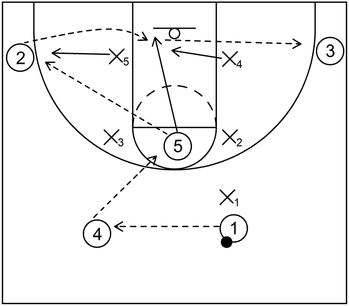
This is an example of zone offense that could be used against the 1-2-2 zone defense. To begin, 4 receives the ball from 1 and quickly makes the high post entry pass to 5.
Afterwards, 2 receives the ball from 5 at the high post. Next, X5 will most likely closeout to prevent the open jump shot. When that occurs, 5 immediately dives to the basket and can receive the ball from 2.
Also, X4 would probably move into the lane to contest a shot attempt by 5. When that happens, 5 can quickly pass to 3 in the right side corner. X4 most likely will not have enough time to recover and 3 can take the open jump shot.
Example 2
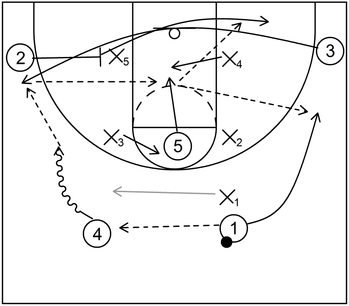
This is another example of zone offense that could be executed against the 1-2-2 zone defense. To start, 4 receives the ball from 1 as within the previous diagram.
However, this time, X3 takes away the high post option by denying the entry pass. When that happens, 4 dribbles towards the wing while being pursued by X1.
At the same time, 3 cuts to the left side corner via a baseline screen set by 2 and receives the ball from 4. Additionally, 2 cuts to the right side short corner after setting the screen. Next, 3 can take the open corner three-point shot.
If X5 fought through the screen and prevented the open shot, then 5 can dive cut to the basket and receive the ball from 3. X4 will most likely slide into the lane to protect the basket and prevent the easy layup.
Also, as that action occurs, 1 cuts to the right side wing. Following that, 5 could pass to 1 or 2 for jump shot opportunities.
What are examples of 1-3-1 zone offense
Example 1
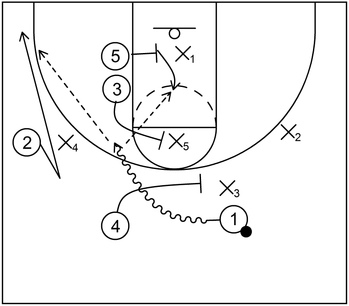
This is an example of zone offense that could be used to beat the 1-3-1 zone defense. To begin, 1 dribbles into the gap of the zone near the left side high post via the on-ball screen set by 4. At the same time, 1 also receives another on-ball screen from 3 while X1 gets cross screened by 5.
As that action happens, 2 drifts toward the left side corner from the left side wing. Following that, 2 could receive the ball from 1 and take the open three-point jump shot.
Additionally, 5 could quickly post up near the dotted line after setting the cross screen, receive the ball from 1, and then score with a low post move near the basket.
Example 2
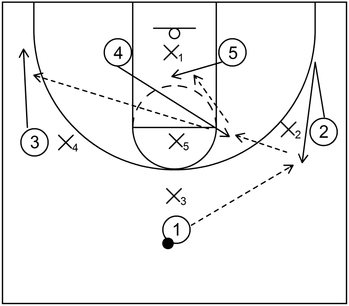
This is another example of zone offense against the 1-3-1 zone defense. To start, 2 makes a v-cut to get open and receives the ball from 1. Next, 4 flashes across the lane to the right side elbow and receives the ball from 2.
Afterwards, 5 quickly ducks into the lane, seals the defender under the basket, receives the ball from 4 via high low action, and scores near the basket with a low post move.
Also, if the high low option is not there, then 4 could execute a skip pass to 3 who drifts to the left side corner for a jump shot opportunity.
What are examples of 1-4 High zone offense
Example 1 – Part 1

This is an example of zone offense that starts with the 1-4 high alignment. To begin, 3 receives the ball and quickly reverses it back to the top.
Next, 2 receives the ball from 1 and after that, 3 begins to cut towards the right side short corner. Also, X2 and X5 shift to the high and mid post to deny high post passes.
Example 1 – Part 2
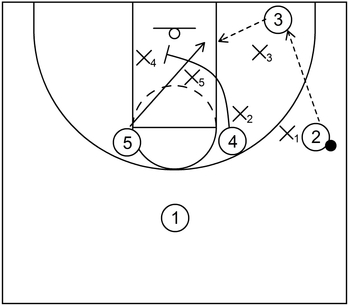
Next, 3 receives the ball from 2 and could take the short corner jump shot if open. However, if 3 is not open, then 4 could screen X4 and 5 could dive to the basket. Following that, 5 could receive the ball from 3 and score near the rim.
Example 2 – Part 1

This is another example of zone offense from the 1-4 high set. To start, 1 dribbles toward the right side wing area via an on-ball screen set by 2.
As that happens, 5 cuts toward the short corner area via a cross screen set near the basket on the back-side defender.
After that, 5 could receive the ball from 1 and take the short corner jump shot or score near the basket. Additionally, after the screening action, 4 could cut across to the left side low post area.
Example 2 – Part 2

Next, 2 could drift down to the left side corner via the flare screen set by 3. At the same time, 4 could set a screen on the back side defender to limit/prevent the potential closeout.
Following that, 2 could receive the skip pass from 1 and then take the three-point jump shot if open.
What are examples of 1-4 Low zone offense
Example 1
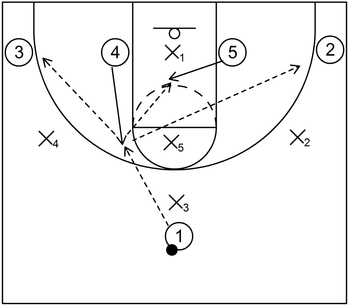
This is an example of zone offense initiated from a 1-4 low set against a 1-3-1 zone defense. To begin, 4 cuts to the left side elbow area and receives the ball from 1.
Next, 5 immediately ducks in near the basket, receives the ball from 4, and then scores with a low post move. Additionally, 2 or 3 could also receive the ball from 4 and then shoot corner three-point shots if open.
Example 2
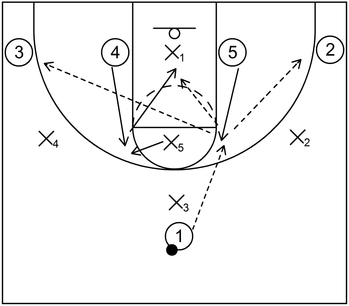
This is an alternative to the previous diagram in which 4 cuts to the left side elbow but this time, X5 denies the entry pass. When that happens, 5 cuts to the right side elbow and quickly receives the ball from 1.
Next, 4 dives to the rim, seals X1 under the basket, receives the ball from 5, and then scores with a low post move. Also, as a secondary option, 2 or 3 could receive the ball from 5 for potential corner jump shot opportunities.
What are examples of 2-1-2 zone offense
Example 1
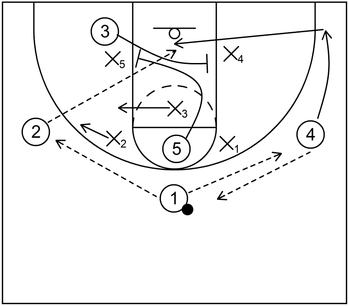
This is an example of zone offense action that could be used to create scoring opportunities against a 2-1-2 zone defense.
To start, 4 receives the ball from 1, reverses it back to the top immediately, and then cuts to the right side corner. Next, 2 receives the ball from 1 which seeks to shift the zone.
After that, 3 and 5 set screens on the back side zone defenders. As that happens, 4 cuts to the basket, receive the ball from 2 and score before the defense can recover.
Example 2
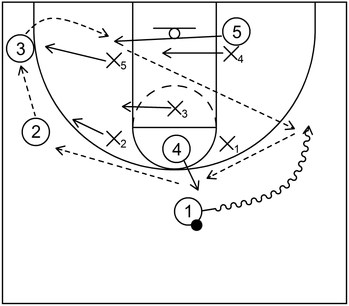
This is another example of a zone offense play vs. a 2-1-2 zone defense. To begin, 1 dribbles toward the right side wing and as that happens, 4 pops out from the high post to the top and receives the ball from 1.
Next, 2 receives the ball from 4 and then 3 receives the ball from 2. As this occurs, the zone should shift over towards the left side of the court.
Afterwards, 5 cuts across the lane to the left side low post area and can receive the ball from 3. From there, 5 can score near the basket or 1 could receive the ball from 5 via a skip pass and then take the open jump shot.
What are examples of 2-3 zone offense
Example 1 – Part 1
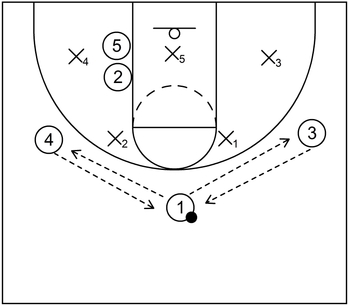
This is an example of a zone offense set vs. a 2-3 zone defense derived from the Kansas Jayhawks men’s basketball team and it features reversal action and on-ball screens.
3 receives the ball from 1 and immediately reverses it back to the top. Next, 4 receives the ball from 1 and then reverses it back to the top once again.
Example 1 – Part 2
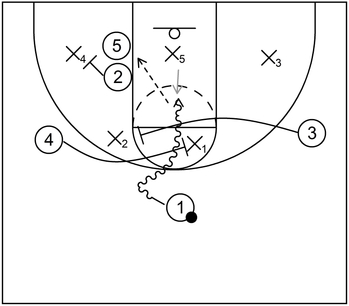
Immediately after the second reversal pass, 4 receives a ram screen from 3 who cuts across the high post. From that point, 4 uses the ram screen to set a ball screen for 1.
Next, 1 takes the ball screen and quickly splits the two defenders at the top of the zone. At the same time, 5 receives a quick screen from 2 near the baseline.
Following that, 1 can take the mid-range jump shot in the lane. Also, 5 could receive the ball from 1 for a close range scoring opportunity if X5 steps up to contest the possible jump shot, shown with the gray arrow.
Example 2 – Part 1
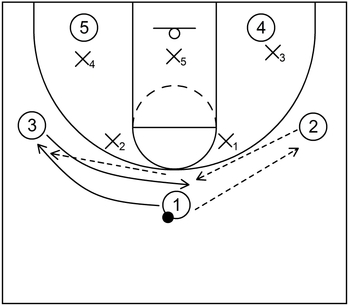
This set vs. the 2-3 zone comes from the Kansas State Wildcats and it features ball reversals and flash cuts to create scoring possibilities.
The action starts with a 3 out 2 in motion variation which has the post players at the short corners instead of the low post blocks.
To begin, 2 receives the ball from 1 and following that, 1 and 3 interchange spots as the zone shifts. Afterwards, 3 receives the ball from 2 and then reverses it again to 1.
Example 2 – Part 2
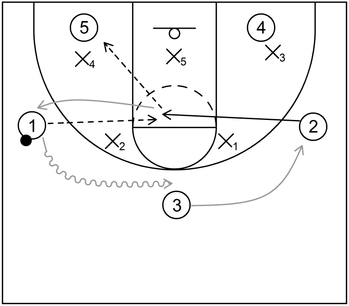
2 flashes into the middle of the zone and receives the ball from 1. At this point, 2 could shoot the mid-range jump shot if open. Also, 2 could make the high low pass to 5 at the short corner who could shoot the short jump shot/layup.
Additionally, there is an alternative option represented by the gray arrows. If 2 is not open after the flash cut occurs, then 1 could dribble towards the top.
At the same time, 2 continues the cut to replace at the left side wing and 3 cuts to the empty right side wing.
Example 2 – Part 3
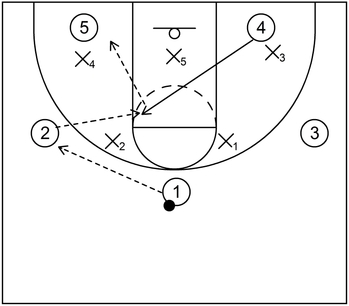
Continuing on, 2 receives the ball from 1 and as that happens, 4 quickly flashes into the gap of the zone. Next, 4 can take the jump shot if open or execute the high low action with 5 who could score from the short corner or near the basket.
Example 3

This 2-3 zone offensive quick hitter comes from the North Carolina men’s basketball team and it features a flash cut and high low action. 3 receives the ball from 1 and quickly reverses it back to the top.
Next, 2 receives the ball from 1 and as that happens, 5 flashes into the gap of the zone near the right side elbow. Following that, 5 receives the ball from 2 and once that occurs, 4 cuts directly to the basket from the right side corner.
Afterwards, 4 receives the ball from 5 via high low action and can score near the rim with a layup or dunk.
Example 4 – Part 1

This set comes from John Beilein during his time as the head coach of the Michigan Wolverines basketball team. It also features overload action against the 2-3 zone defense.
1 dribbles toward the right side wing and as that happens, 2 and 3 lift up from the corners to the wings. Next, 2 receives the ball from 1 via a pitch pass and following that, 1 cuts down to the empty right side corner.
Example 4 – Part 2
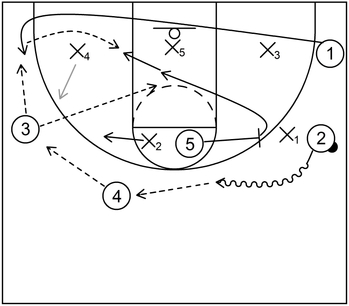
After receiving the ball, 2 dribbles toward the top via an on-ball screen set by 5. Following that, 4 receives the ball from 2 and quickly reverses it to 3.
As that happens, 1 runs the baseline to the left side corner. At the same time, 5 rolls to the basket after setting the on-ball screen.
From that point, 5 could receive the ball from 3 and score near the basket if that is open. Additionally, if X4 bumps up to take away the potential jump shot from 3, shown with the gray arrow, then 1 could receive the ball and shoot the jump shot instead.
Also, if 1 received the ball but X4 was able to closeout near the corner, then 5 can continue to the left side low post block, receive the ball from 1, and score near the basket with a low post move.
What are examples of 3 out 2 in zone offense
Example 1 – Part 1

This is an example of a zone offense set play that starts with the 3 out 2 in alignment. To begin, 1 dribbles toward the left side wing area which then triggers 3 to execute a shallow cut to the top.
As that occurs, 4 cuts to the left side corner via a cross screen set by 5 to occupy the backside defenders. Following that, 3 receives the ball from 1 and then, 2 receives the ball from 3.
Example 1 – Part 2
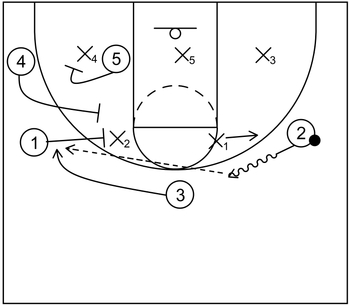
Next, 2 dribbles toward the extended right slot and as that happens, 3 cuts away to the left side wing and receives a pair of flare screens from 1 and 4.
Afterwards, 3 can receive the ball from 2 via a skip pass and take the open jump shot. In addition, 5 can also screen the potential help defender on the ball side as well.
Example 2 – Part 1
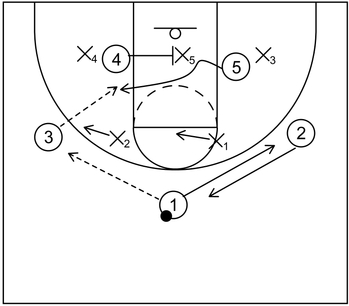
This is another example of zone offense from a 3 out 2 in alignment. To start, 3 receives the ball from 1 and after that, 5 cuts to the left block by way of a cross screen on X5.
Following that, 5 could receive the ball from 3 and score with a mid-range jump shot or score near the basket. In addition to this action, 1 and 2 exchange spots on the floor.
Example 2 – Part 2
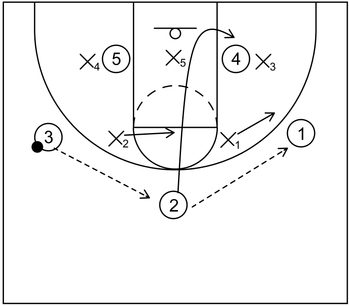
If 5 does not receive the ball from 3, then 2 could receive the ball instead. Afterwards, 1 can receive the ball from 2 and from that point, 2 cuts to the short corner directly behind 4.
Example 2 – Part 3
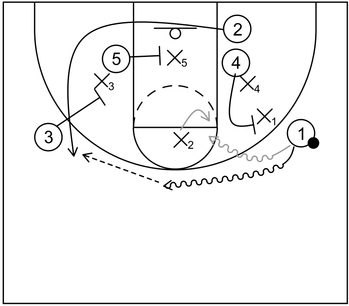
Next, 1 receives a on-ball screen set by 4 and a couple of scenarios can develop from there. If 1 can get into the gap of the zone, represented by the gray arrow, then 1 can shoot the mid-range shot.
Conversely, if X2 slides over to high post to close the gap, shown with the gray arrow, then 1 could dribble towards the top as an alternative option.
Additionally, as that happens, 2 could cut to the left side wing area via the screens set by 3 and 5. Afterwards, 2 receives the ball from 1 and could take the open jump shot.
Affiliate Disclosure: I may earn a commission on qualifying purchases made through the links below.
What are examples of 4 out 1 in zone offense
Example 1 – Part 1
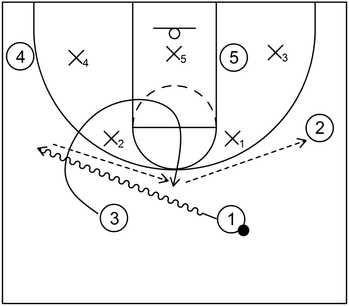
This is an example of zone offense action initiated from a 4 out 1 in formation.
To begin, 1 dribbles to the left side wing which then triggers 3 to execute a shallow cut to the top. Following that, 3 receives the ball from 1 and afterwards, 2 receives the ball from 3.
Example 1 – Part 2
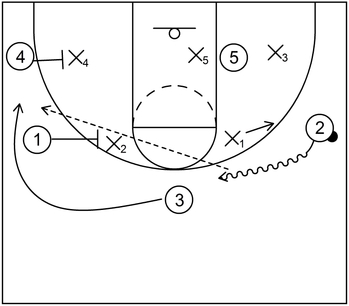
Next, 2 begins to dribble towards the top and as that happens, 3 cuts to the left side wing by way of flare screens set by 1 and 4. After that, 3 receives the skip pass from 2 and can shoot the open three-point jump shot.
Example 2 – Part 1

This is yet another example of a zone offense set initiated from the 4 out 1 in formation. To start, 2 receives the ball and quickly reverses it back to the top.
Following that, 4 receives the ball from 1 and then 3 receives the ball from 4. Afterwards, 1 cuts through to the left side corner.
Example 2 – Part 2
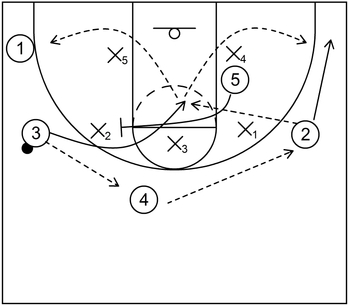
Next, 4 receives the ball from 3 and then 2 receives the ball from 4. Following that, 3 cuts to the middle of the zone via a high post screen set by 5.
From that point, 3 receives the ball from 2 and can take the open mid-range jump shot. However, if X4 or X5 executes a closeout to prevent that open jump shot, then 1 or 2 could receive the ball from 3 and take corner jump shots if open.
Example 3 – Part 1
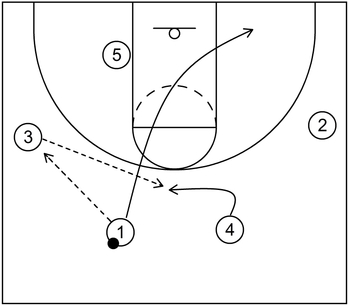
This is an example of a 4 out 1 in offensive set that could produce a good shot against a 2-3 zone defense and it is derived from How to Beat a Zone Defense by Chris Mack.
To start, 3 receives the ball from 1 and then, 1 cuts through to the right side short corner.
After that, 4 cuts to the top and receives the ball from 3.
Example 3 – Part 2
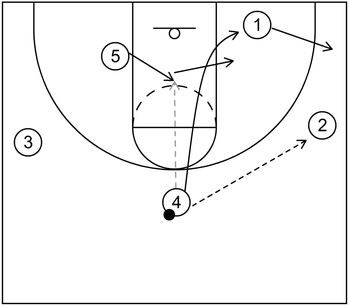
Next, 5 quickly flashes into the lane and could receive the ball from 4, shown with the gray arrow, if that is open.
If it is not open, 2 receives the ball from 4 instead and this triggers 5 to cut across to the right side low post block.
At the same time, 4 cuts through to the right side short corner and 1 fills the right side corner behind the three-point line.
Example 3 – Part 3
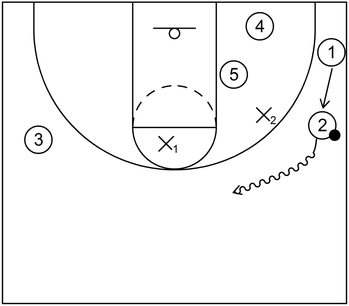
Next, 2 dribbles toward the right slot area and this would essentially influence the strong side top defender, in this case X2, to apply pressure to the ball.
As that happens, 1 fills the vacant right side wing area. Also, if the strong side defender does not apply pressure, then 2 could simply take the open three-point jump shot.
Example 3 – Part 4
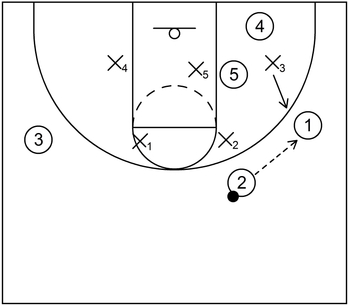
After that, 1 receives the ball from 2 and when that happens, the strong side back defender, in this case X3, would most likely closeout and contest the potential jump shot of 1.
However, if X3 does not move, then 1 could take the jump shot if that is open.
Example 3 – Part 5a
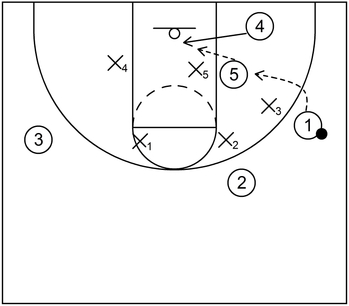
If X3 executes the defensive closeout, then 5 could receive the ball from 1. When that occurs, the main rim protector, which in this case is X5, now has to guard 4 and 5.
So, when 5 receives the ball, 4 immediately cuts to the rim from the short corner. Following that, 4 receives the ball via a bounce pass from 5, then scores at the basket.
Example 3 – Part 5b
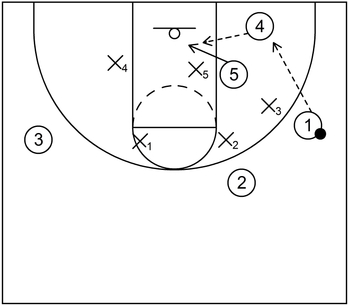
If 5 could not receive the ball from 1, then 4 could receive it instead. Afterwards, 5 should cut to the rim and receive the ball from 4 via a bounce pass. Following that, 5 could score at the rim.
Example 3 – Part 5c
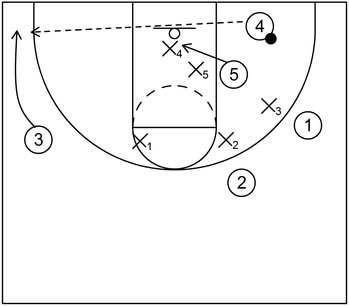
If 4 receives the ball but X4 slides into the lane to provide help defense against the cutting action of 5, then 3 could drift into the left side empty corner. After that, 3 could receive the ball from 4 and take the open jump shot.
What are examples of 5 out zone offense
Example 1
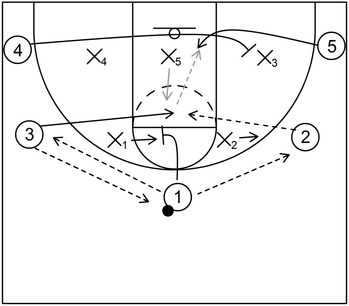
This is an example of zone offense initiated from the 5 out formation. To start, 1 and 3 execute ball reversal and then 2 receives the ball from 1.
Next, 3 flashes into the lane by way of a high post cross screen set by 1 and receives the ball from 2.
Also, at the same time, 5 cuts into the lane from the right side corner via a cross screen set by 4. Following that, 3 could take the open jump shot or execute high low action with 5 if X5 steps up to contest the jump shot, shown with gray arrows.
Example 2
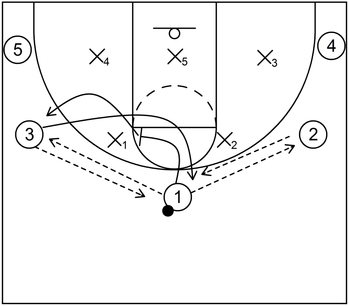
This is another example of zone offensive action from a 5 out alignment. From the start, 3 receives the ball from 1 and quickly reverses it back to the top. Next, 2 receives the ball from 1 and then, 3 cuts to the top via a screen set by 1.
Following that, 3 can take the jump shot if open. Additionally, 1 cuts out to the left side wing and could receive the ball from 3 if that is open.
Example 3
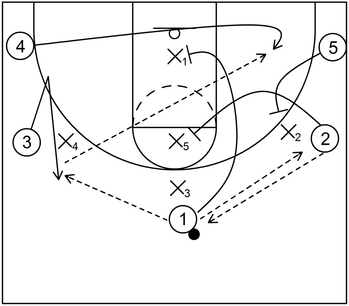
This is an example of 5 out zone offense against a 1-3-1 zone defense. 2 receives the ball from 1 and quickly reverses it back to the top. Next, 3 executes a v-cut and receives the ball from 1.
Following that, 4 cuts to the right side short corner via screens set by 1, 2, and 5. Afterwards, 4 receives the ball from 3 via a skip pass and can take the open short corner jump shot.
What are examples of the baseline runner zone offense
Example 1 – Part 1
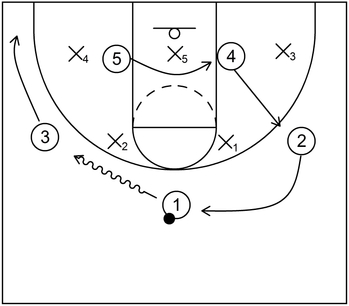
This is an example of the baseline runner zone offense which, as the name implies, features an offensive player that runs along the baseline to create scoring opportunities.
To begin, 1 dribbles to the left side wing and as that occurs, 2 cuts to the top, 3 drifts to the left side corner, 4 pops out to the right side wing, and 5 cuts across the lane to the right side low post block.
Example 1 – Part 2
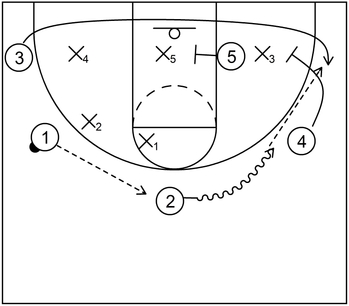
Next, 2 receives the ball from 1 who then begins to dribble towards the right side wing. As that happens, 3 executes a baseline cut to the right side corner via screens set by 4 and 5. Afterwards, 3 receives the ball from 2 and then takes the open jump shot.
Example 2
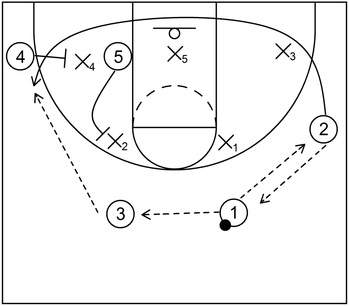
For this example, 2 receives the ball from 1 and reverses it back to the top. After that, 3 receives the ball and as that happens, 2 executes a baseline cut to the left side corner via a screen set by 4. Next, 2 receives the ball from 3 and can take the open jump shot.
Example 3
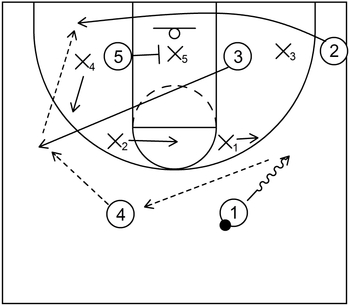
Here is another example of the baseline runner action against a 2-3 zone defense. From the beginning, 1 dribbles toward the right side wing, causing the zone to shift, and then 4 receives the ball from 1.
Next, 3 cuts across the lane to the left side wing and at the same time, 2 runs baseline to the left side short corner via a screen set by 5.
Following that, 3 receives the ball from 4 and could take the jump shot if open. Conversely, if X4 executes the bump action to closeout on 3, then 2 could receive the ball from 3 and shoot the short corner jump shot.
Example 4
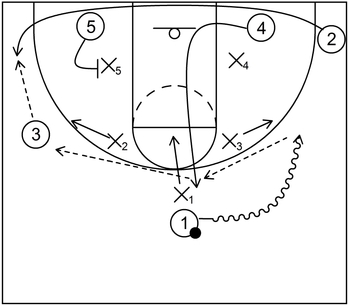
This is an example of a baseline runner vs. a 1-2-2 zone defense. 1 dribbles toward the right side wing to shift the zone defenders. As that happens, 4 executes a zipper cut to the top and receives the ball from 1.
Next, 3 receives the ball from 4 and at the same time, 2 runs the baseline to the left side corner via a screen set by 5. From that point, 2 could receive the ball from 3 and take the open corner jump shot.
What are examples of the European ball screen zone offense
Part 1
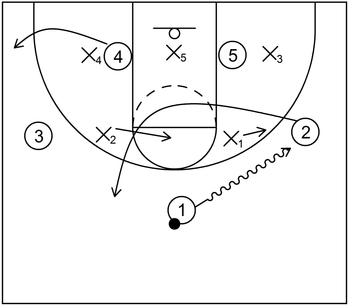
This is an example of the European ball screen zone offense which uses an on-ball screen to attack the 2-3 zone defense. To start, 1 dribbles to the right side wing which triggers a shallow cut to the left side slot by 2. Also, as that happens, 4 cuts out from the low post block to the left side corner.
Part 2
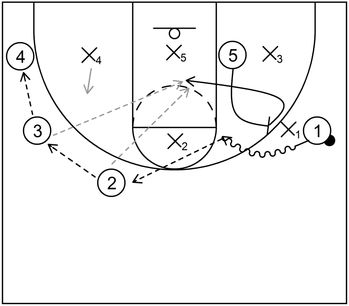
Next, 1 dribbles into the gap of the zone via an on-ball screen set by 5 who also rolls to the basket. Once that happens, if X1 fights over the screen and/or X2 slides over to stop the dribble penetration, then 2 could receive the ball from 1. Following that, 2 could take the open jump shot.
Also, 3 could receive the ball from 2 and take the open jump shot if X2 recovers and executes a closeout on 2. Additionally, 4 could receive the ball from 3 if X4 bumps down to closeout on 3, shown with the gray arrow.
Furthermore, as an alternative option shown with gray dotted arrows, 5 could receive the ball from 2 or 3 and score near the basket.
What are examples of the Horns zone offense
Example 1 – Part 1
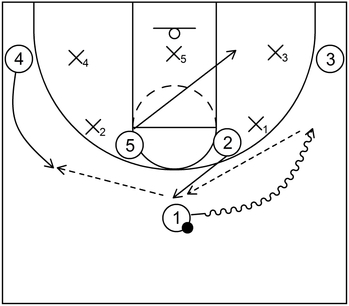
This is an example of zone offense initiated from a Horns alignment.
To start, 1 dribbles toward the right side wing and at the same time, 5 cuts across the lane to the right side low post block, 2 pops out to the top, and 4 lifts up to the left side wing. Next, 2 receives the ball from 1 and then, 4 receives the ball from 2.
Example 1 – Part 2

Next, 4 dribbles toward the left slot and as that happens, 2 cuts away to the right side wing via flare screens set by 1 and 3. Afterwards, 2 can receive the ball from 4 and take the open three-point jump shot.
Additionally, if the zone defenders were able to fight through the screens to prevent the open jump shot, then 5 could receive the ball from 2 and score quickly with a low post move near the basket.
Example 2 – Part 1
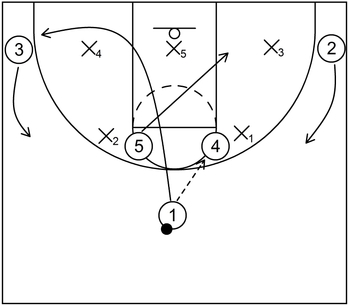
This is another example of zone offense from a Horns alignment. To begin, 4 receives the ball at the high post from 1 who also cuts to the left side corner.
At the same time, 2 and 3 move from the corners to the wings and 5 cuts down to the right side low post block.
Example 2 – Part 2
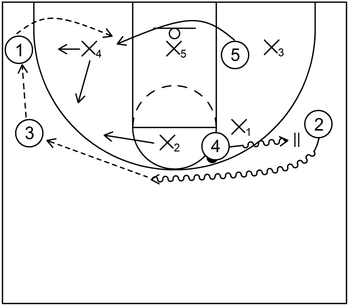
Next, 2 receives the ball from 4 via a dribble hand off and after that, 2 dribbles to the top. At the same time, 5 cuts across the lane towards the left side low post block.
Following that, 3 receives the ball from 2 and can take the jump shot if X4 does not closeout via the bump technique or X2 does not recover to closeout in time.
Conversely, if X2 or X4 were able to prevent the open jump shot, then 1 could receive the ball from 3 and take the corner three-pointer if open.
Additionally, if 1 received the ball but X4 is able to closeout on the ball, then 5 could receive the ball from 1 and score quickly with a low post move near the basket.
What is the flood zone offense with examples
The flood zone offense uses the overload concept to create perimeter or post scoring opportunities against zone defense such as the 2-3 zone or 1-3-1 zone.
As the name implies, the flood (or overload action) occurs when one side of the court contains more offensive players than zone defenders and for this zone offense, those court spots are the wing, corner, and low post block.
Part 1
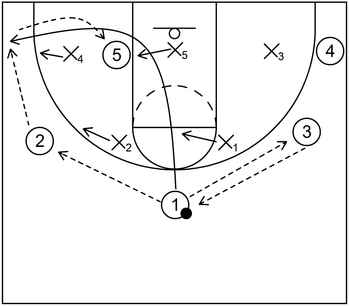
This is an example of the flood zone offense derived from Offensive Success vs. a Switching Man to Man Defense by Craig Doty.
To begin, 3 receives the ball from 1 and quickly reverses it back to the top. Next, 2 receives the ball from 1 and cuts through to the left side corner.
After that, 1 can receive the ball from 2 and take the jump shot if open. Alternatively, 5 could receive the ball from 1 and quickly score with a low post move.
Part 2a
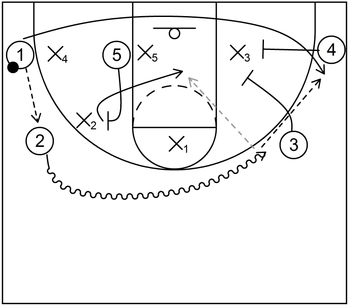
If the corner jump shot is not open and 5 does not receive the post entry pass either, then 2 could receive the ball from 1. Afterwards, 2 could begin to dribble towards the right side wing via a ball screen set by 5.
At the same time of the dribble action, 1 begins to baseline cut to the right side corner via double screens from 3 and 4. Next, 1 receives the ball from 2 and could take the open three-point jump shot.
Additionally, as a secondary option, 5 could roll to the middle of the zone after setting the screen, receive the ball from 2, shown with the gray dotted arrow, and score near the basket.
Part 2b
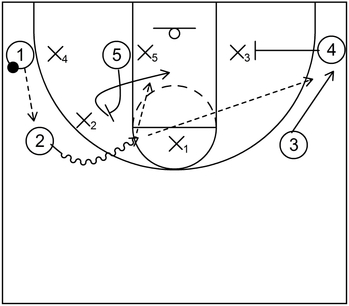
Here is another scoring option when 1 receives the ball in the corner but does not shoot or make the post entry pass. 2 receives the ball from 1 and then receives a ball screen from 5 as before.
However, this time, 2 dribbles into the gap of the zone between X1 and X2. As that action happens, 3 receives a screen from 4 and cuts to the right side corner.
Next, 3 receives the ball from 2 via a skip pass and can take the open three-point corner shot.
Also, as an alternative scoring possibility, 5 could receive the ball from 2 by cutting to the middle of the zone after setting the screen. From that point, 5 could score near the basket or take the short jump shot in the lane.
What is the rotation continuity zone offense with examples
The rotation continuity zone offense features concepts such as ball reversal, attacking the gaps, and executing high low action with the objective of breaking down the zone defense to create scoring opportunities near the basket or from the perimeter.
Additionally, this zone offense includes a continuity pattern to produce more potential scoring options on the opposite side of the court.
Part 1
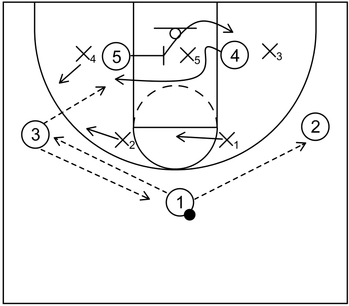
These are diagram examples vs. a 2-3 zone defense based on The Rotation Continuity Zone Offense by Fran McCaffery.
To start, 3 receives the ball from 1 and after that, 4 cuts to the left side low post via a cross screen set by 5. Next, 4 could receive the ball from 3 and score with a low post move if that is open.
If the low post option is not there, then 1 receives the ball from 3 and then 2 receives the ball from 1. Also, on that reversal action, 5 cut across to the right side low post block following the initial cross screen.
Part 2
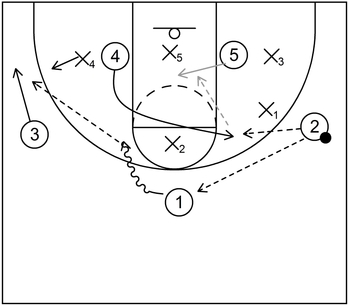
Next, 4 flashes across to the right side high post looking to receive the ball from 2. From there, if 2 can get the ball into the high post, then the high low option between 4 and 5 may be possible, represented by the gray arrows. Otherwise, ball reversal happens and 1 receives the ball from 2.
Afterwards, 1 drives into the gap of the zone toward the left side elbow. Also, as that happens, 3 drifts toward the mid-post extended area between the left side wing and corner, receives the ball from 1, and can take the three-point shot if X4 does not closeout on the ball.
Part 3
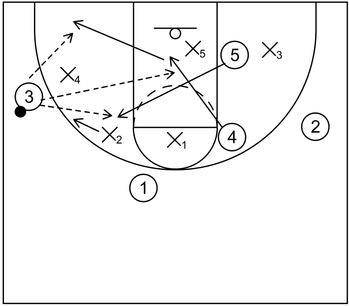
If X4 executes a closeout to take away the open jump shot from 3, then 4 can cut to middle of the zone, receive the ball from 3, and score near the basket. Conversely, if 4 is not open, then 4 continues the cut to the left side short corner.
Additionally, after 4 cuts to the short corner, 5 executes a flash cut to the left elbow, receives the ball from 3, and can take the mid-range jump shot if open.
Furthermore, if 5 is not open, then 4 could receive the ball from 3 and take the short corner jump shot.
Part 4
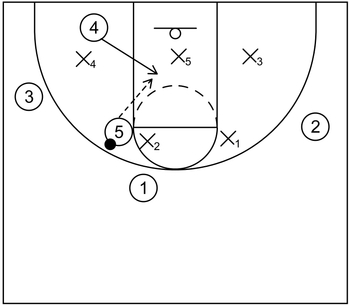
Here is an example in which 5 receives the ball from 3 but could not take the mid-range jump shot. When that occurs, 4 could flash into the lane from the short corner and receive the ball from 5 via the high low action. After that, 4 could score near the basket with a low post move or layup.
Part 5
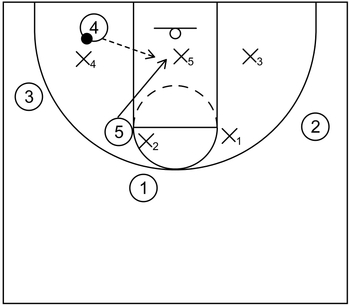
Here is an example in which 4 receives the ball from 3 but could not take the short corner jump shot. When that happens, 5 could dive cut to the basket and receive the ball from 4. Afterwards, 5 could score near the rim with a low post move or layup.
Part 6
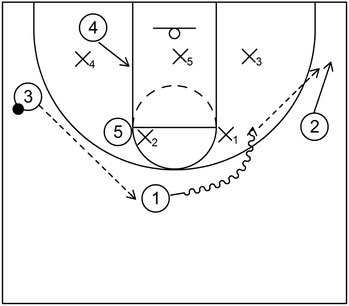
This is an example of the continuity pattern within the rotation continuity zone offense. If 4 or 5 does not receive the ball from 3, then 1 could receive the ball from 3 instead.
When that occurs, 1 dribbles into the gap of the zone near the right side elbow while 2 drifts to the mid-post extended area between the right side wing and corner.
Afterwards, 2 could receive the ball from 1 and take the open jump shot if X3 does not closeout in time. Additionally, while that action occurs, 4 cuts to the left side low post from the left side short corner.
Part 7

If 2 is not open for the jump shot, then 4 flashes to the right side elbow, receives the ball from 2 and could take the mid-range jump shot if open.
If 4 is not open, then 5 could cut towards the basket, receive the ball from 2, and score near the rim with a low post move or layup.
If 5 is not open near the basket, then 5 could continue out to the right side short corner, receive the ball from 2, and take the short corner jump shot.
If none of those options are available, then 1 could receive the ball from 2 and execute the continuity pattern again on the opposite side of the court.
What is the short corner zone offense with examples
The short corner zone offense, as the name implies, utilizes the short corners of the court to create scoring opportunities against zone defenses such as the 2-3 zone.
The primary scoring options within the examples below include a short corner jump shot, a possible layup via a quick basket cut, or a low post scoring option.
Additionally, offensive players can shift the zone defense via ball reversal and generate a continuity pattern as well.
Part 1
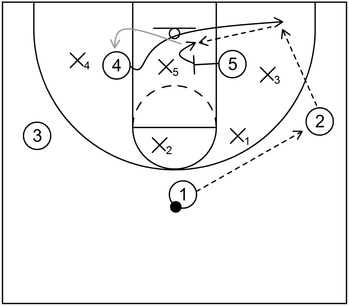
To begin, 2 receives the ball from 1 and as that happens, 4 cuts to the right side short corner by way of the cross screen set by 5. Next, 4 can receive the ball from 2 and as that occurs, 5 pivots toward the ball with high hands.
From this point, 4 can either shoot the short corner jump shot if open or 5 could receive the ball from 4 and score with a low post move near the basket.
Also, if 5 does not receive the ball from 4, then 5 can cut away from the ball to the opposite low post block, represented by the gray arrow.
Part 2
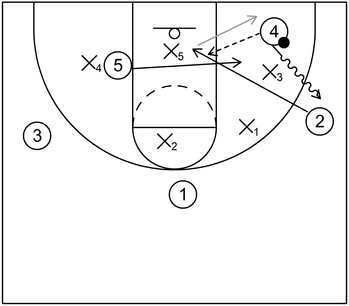
Next, 2 can cut to the basket after making the short corner pass and receive the ball from 4 if that is open. If 2 is not open on the basket cut, then 4 can dribble away from the zone towards the right side wing area.
At the same time, 2 can relocate to the right side short corner, shown with the gray arrow. Also, 5 can cut across the lane to the right side low post area.
Part 3
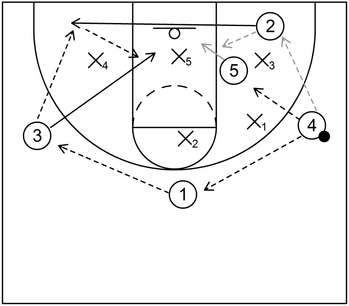
Next, 5 can receive the ball from 4 and score with a low post move near the basket. Additionally, 2 can receive the ball from 4, shown with the gray dotted arrow, and take the jump shot if open.
Also, 5 could execute a small cut to the basket, receive the ball from 2, and then score near the rim, shown with gray arrows.
Conversely, if none of those options are available, then the offensive continuity can begin. 1 receives the ball from 4 and then, 3 receives the ball from 1.
Additionally, at the same time of the ball reversal action, 2 runs the baseline to the left side short corner, receives the ball from 3, and could take the short corner jump shot.
Furthermore, if 2 does not take the jump shot, then 3 could cut to the basket, receive the ball from 2, and score near the rim.
Part 4
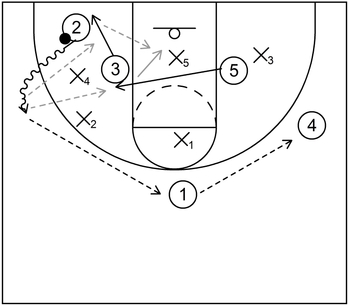
If 3 is not open upon cutting to the basket, then 2 could dribble out towards the left side wing while 3 fills the left side short corner. Additionally, as that happens, 5 cuts across the lane towards the left side low post block.
After that, 5 can receive the ball from 2 represented by the gray arrow. As another option, 3 could receive the ball from 2 and then 5 can execute a small cut to the basket, also represented by gray arrows.
If those options are not available, then the continuity could get executed once again by 1 receiving the ball from 2 and then 4 receiving the ball from 1.
What is the slice and dice zone offense with examples
The slice and dice zone offense features a two-guard front and its primary goal is to attack the gaps of the zone near the high post areas or get the ball into the low post areas by way of ball reversal.
Additionally, the the slice and dice zone offense was initially developed by Jim Larranaga during his time as the head coach at George Mason University.
Part 1
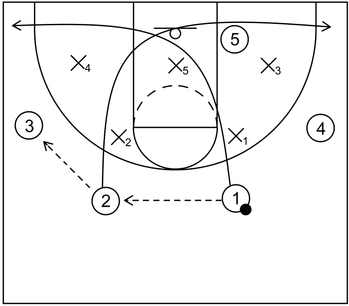
This is an example of the slice and dice action executed against a 2-3 zone defense based on 3 Zone Offenses to Beat Any Zone Defense by Jim Larranaga.
To begin, 2 receives the ball from 1 and then 3 receives the ball from 2. Following that, 1 cuts through to the left side corner while 2 cuts through to the right side corner.
Part 2

Next, 3 dribbles to the left side extended slot to shift the position of X2 towards the ball. If X2 does not move towards the ball, then 3 can take the open jump shot.
Following that, 4 cuts into the gap of the zone and at the same time, 5 cuts across to the left side short corner. Afterwards, 4 receives the ball from 3 and could take the mid-range jump shot if open.
From this point, there are different alternative scoring options represented by the gray arrows on the diagram. If X5 executes a closeout on 4, then 5 could step into the lane, receive the ball from 4 via high low action, and score near the basket.
Furthermore, if X4 takes away the high low action, then 1 could receive the ball from 4, and then take the open three-point shot.
Part 3
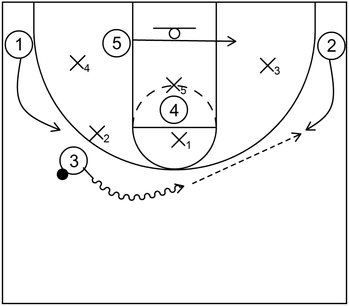
Here is an example in which 4 cut into the gap of the zone but could not receive the ball from 3. When that occurs, 3 dribbles to the top and as that happens, 5 cuts back across to the right side low post area.
Also, at the same time, 1 and 2 move to the wings from the corners. Next, 2 receives the ball from 1.
Part 4

If X3 bumps to closeout on the ball, then 5 could receive the ball from 2 and score with a low post move near the rim. Also, as a secondary option, if 5 is not able to score with a low post move, then 4 could dive to the dotted lane lane, receive the ball from 5, and take the mid-range jump shot.
Related: Best Zone Offense Versus 2-3 Zone – YouTube